 |
Figure 1. Figure showing the U.S. Exclusive Economic Zone (EEZ) boundaries and the location and extent of the GLORIA sidescan-sonar survey areas. |
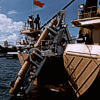 |
Figure 2. The GLORIA sidescan-sonar vehicle (or fish) as it is prepared to be lowered into the water from the stern of a research ship. |
 |
Figure 3. The diagram shows a ship towing a sidescan-sonar vehicle and the strip of seafloor insonified by the instrument. Graphic courtesy of U.S. Geological Survey, Coastal and Marine Science Center, Woods Hole, MA 02543. |
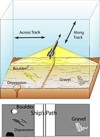 |
Figure 4. Towfish is shown at apex of across-track beam of energy (yellow fan-shaped area) and the resulting sonograph. Previously insonified area shown as light grey area, with corresponding image to features depicted below. The ship's nadir is represented on the sonograph as a thin white line, and the two black sections adjacent to the nadir represent the water-column which is removed during processing. The brown stripe below the towfish shows the along-track dimension. Figure adapted from Able, K.W., Twichell, D.C., Grimes, C.B., and Jones, R.S., 1987, Sidescan sonar as a tool for detection of demersal fish habitats: Fishery Bulletin, v. 85, p. 725-736. Graphic courtesy of U.S. Geological Survey, Coastal and Marine Science Center, Woods Hole, MA 02543. |
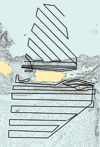 |
Figure 5. This image shows a typical survey trackline taken during the acqusition of the GLORIA sidesscan-sonar data. This survey represents the EEZ GLORIA Puerto Rico survey from November 4, 1985, to December 3, 1985. For more information regarding this survey please refer to the USGS, Woods Hole Science Center Data Archives field activity 1985-039-FA. |
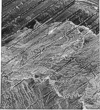 |
Figure 6.The Gulf of Mexico GLORIA mosaic number 13 illustrates a processed and digitally mosaicked dataset. The imagery shows a highly reflective area that marks submarine debris-flow deposits. A meandering channel shown as a bright sinuous line in the upper right quadrangle of the image emerges from the deposits and trends southward, parallel to the Florida Escarpment. The dark, narrow stripes seen in the image denotes the ship's nadir, which are non data areas. They indicate the path of the sidescan fish, and thus, the source of sonar beams; they can be ignored. |
 |
Figure 7. Flowchart illustrating an overview of typical processing steps for a 6-hour-long GLORIA pass. |
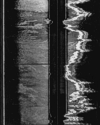 |
Figure 8. Example of a raw GLORIA data file. Each line of this 6-hour-long GLORIA pass contains a 30-second swath, 924 pixels wide, and 720 lines in length. The first 32 bytes of each line is the swath header information and contains the date, time, and position of the swath and depth. The image illustrates the water-column offset produced by the distance the sonar vehicle is towed above the seafloor (Twichell, 1988). |
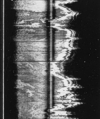 |
Figure 9. Slant-range corrected 6-hour-long GLORIA pass. This processing step corrects slant-range to ground-range and removes the water-column gap in the image. The water-column offset is the distance the sonar vehicle is above the seafloor. Slant-range error is mislocation of pixels in the across-track direction compared to their proper location on a map because the sensor is measuring range distance from a point above the seafloor rather than horizontal distances to the seafloor. After the slant-range correction has been made, the across-track location of targets is accurate (Twichell, 1988). |
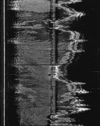 |
Figure 10. A 6-hour-long GLORIA pass after the shading correction has been applied. Result of this correction is normalization of the data in the near and far range so they can be compared directly with each other. (Twichell, 1988) |
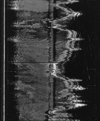 |
Figure 11. A 6-hour-long GLORIA pass after the the striped noise removal procedure was applied. The correction involves combining two filtered components of the image. One image contains the high-frequency (high-pass filter) component of every line without the noise. The other image contains the low-frequency background brightness (low-pass filter) of a broader swath image without the noise. The high-pass and low-pass images are then combined to recreate an image similar to the original, but without the noise. Compare this improved image with the previous image (fig. 10) (Twichell, 1988). |
 |
Figure 12. The 6-hour-long GLORIA pass with the aspect-ratio distortion corrected and speckle noise removal applied. The applied speckle noise removal filter also helps reduce the blockiness introduced into the image by the aspect-ration distortion correct. This is the final processing of the 6-hour-long pass before digital mosaicking can proceed (Twichell, 1988). |
 |
Figure 13. This image shows the 6-hour-long GLORIA pass after geographic registration of the processed data (Twichell, 1988). |
 |
Figure 14.This image shows the 6-hour-long GLORIA pass after the stenciling procedure. The result of this process is to trim the unwanted data from the registered segment. Compare this stenciled image with the previous step of georeferencing the sidescan-sonar segment (fig. 13) to see the areas trimmed from the image (Twichell, 1988). |
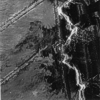 |
Figure 15. Image shows an example of a complete GLORIA digital mosaic (Twichell, 1988). |
|
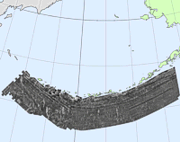 |
Figure 16. The U.S. Exclusive Economic Zone (EEZ) Aleutian Arc area GLORIA sidescan-sonar mosaic south of the Aleutian Islands and the Alaska Maritime National Wildlife Refuge covers about 843,000 square kilometers of seafloor. |
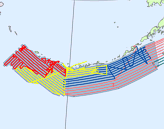 |
Figure 17. Map showing field activities for GLORIA sidescan-sonar data collection in the U.S. Exclusive Economic Zone (EEZ) Aleutian Arc area. |
 |
Figure 18. U.S. Exclusive Economic Zone (EEZ) Aleutian Arc area GLORIA sidescan-sonar mosaic index map. |
 |
Figure 19. The U.S. Exclusive Economic Zone (EEZ) Atlantic East Coast area GLORIA sidescan-sonar mosaic covers approximately 526,772 square kilometers of a passive continental margin. |
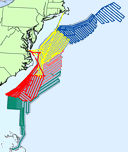 |
Figure 20. Map showing field activities for GLORIA sidescan-sonar data collection in the U.S. Exclusive Economic Zone (EEZ) Atlantic East Coast area. |
|
Figure 21. U.S. Exclusive Economic Zone (EEZ) Atlantic East Coast area GLORIA sidescan-sonar mosaic index map. |
|
Figure 22. The U.S. Exclusive Economic Zone (EEZ) Bering Sea area GLORIA sidescan-sonar mosaic covers approximately 830,000 square kilometers of seafloor. |
|
Figure 23. Map showing field activities for GLORIA sidescan-sonar data collection in the U.S. Exclusive Economic Zone (EEZ) Bering Sea area. |
|
Figure 24. U.S. Exclusive Economic Zone (EEZ) Bering Sea area GLORIA sidescan-sonar mosaic index map. |
|
Figure 25. The Cayman Trough GLORIA sidescan-sonar mosaic covers approximately 51,508 square kilometers of seafloor. |
|
Figure 26. Map showing field activity for GLORIA sidescan-sonar data collection of the Cayman Trough region. |
|
Figure 27. Cayman Trough area GLORIA sidescan-sonar mosaic index map. |
|
Figure 28. The U.S. Exclusive Economic Zone (EEZ) Gulf of Alaska area GLORIA sidescan-sonar mosaic covers approximately 806,000 square kilometers of seafloor. |
|
Figure 29. Map showing field activities for GLORIA sidescan-sonar data collection in the U.S. Exclusive Economic Zone (EEZ) Gulf of Alaska area. |
|
Figure 30. U.S. Exclusive Economic Zone (EEZ) Gulf of Alaska area GLORIA sidescan-sonar mosaic index map |
|
Figure 31. The U.S. Exclusive Economic Zone (EEZ) Gulf of Mexico area GLORIA sidescan-sonar mosaic covers approximately 412,000 square kilometers of seafloor. |
|
Figure 32. Map showing field activities for GLORIA sidescan-sonar data collection in the U.S. Exclusive Economic Zone (EEZ) Gulf of Mexico area. |
|
Figure 33. U.S. Exclusive Economic Zone (EEZ) Gulf of Mexico area GLORIA sidescan-sonar mosaic index map. |
|
Figure 34. The U.S. Exclusive Economic Zone (EEZ) Hawaii I Southeastern Hawaiian Ridge area GLORIA sidescan-sonar mosaic covers approximately 1,068,000 square kilometers of seafloor. |
|
Figure 35. Map showing field activities for GLORIA sidescan-sonar data collection in the U.S. Exclusive Economic Zone (EEZ) Hawaii I Southeastern Hawaiian Ridge area. |
|
Figure 36. U.S. Exclusive Economic Zone (EEZ) Hawaii I Southeastern Hawaiian Ridge area GLORIA sidescan-sonar mosaic index map. |
|
Figure 37. The U.S. Exclusive Economic Zone (EEZ) Hawaii II Central Hawaiian Ridge area GLORIA sidescan-sonar mosaic covers approximately 858,574 square kilometers of seafloor. |
|
Figure 38. Map showing field activities for GLORIA sidescan-sonar data collection in the U.S. Exclusive Economic Zone (EEZ) Hawaii II Central Hawaiian Ridge area. |
|
Figure 39. U.S. Exclusive Economic Zone (EEZ) Hawaii II Central Hawaiian Ridge area GLORIA sidescan-sonar mosaic index map. |
|
Figure 40. The U.S. Exclusive Economic Zone (EEZ) Hawaii III Northwestern Hawaiian Ridge area GLORIA sidescan-sonar mosaic covers approximately 728,000 square kilometers of seafloor. |
|
Figure 41. Map showing field activities for GLORIA sidescan-sonar data collection in the U.S. Exclusive Economic Zone (EEZ) Hawaii III Northwestern Hawaiian Ridge area. |
|
Figure 42. U.S. Exclusive Economic Zone (EEZ) Hawaii III Northwestern Hawaiian Ridge area GLORIA sidescan-sonar mosaic index map. |
|
Figure 43. The U.S. Exclusive Economic Zone (EEZ) Johnston Atoll area GLORIA sidescan-sonar mosaic covers approximately 477,000 square kilometers of seafloor. |
|
Figure 44. Map showing field activities for GLORIA sidescan-sonar data collection in the U.S. Exclusive Economic Zone (EEZ) Johnston Atoll area. |
|
Figure 45. U.S. Exclusive Economic Zone (EEZ) Johnston Atoll area GLORIA sidescan-sonar mosaic index map |
|
Figure 46. The U.S. Exclusive Economic Zone (EEZ) Kingman Reef and Palmyra Atoll area GLORIA sidescan-sonar mosaic covers approximately 215,000 square kilometers of seafloor. |
|
Figure 47. Map showing field activities for GLORIA sidescan-sonar data collection for the U.S. Exclusive Economic Zone (EEZ) Kingman Reef and Palmyra Atoll area. |
|
Figure 48. U.S. Exclusive Economic Zone (EEZ) Kingman Reef and Palmyra Atoll area GLORIA sidescan-sonar mosaic index map. |
|
Figure 49. The U.S. Exclusive Economic Zone (EEZ) Pacific Coast area GLORIA sidescan-sonar mosaic covers approximately 856,000 square kilometers of seafloor. The survey extends from the Mexican border to the Canadian border and from the continental shelf edge at about the 400-m bathymetric contour, to 200 nautical miles from the coast. |
|
Figure 50. Map showing field activities for GLORIA sidescan-sonar data collection for the U.S. Exclusive Economic Zone (EEZ) Pacific Coast area. |
|
Figure 51. U.S. Exclusive Economic Zone (EEZ) Pacific Coast area GLORIA sidescan-sonar mosaic index map. |
|
Figure 52. The U.S. Exclusive Economic Zone (EEZ) Puerto Rico area GLORIA sidescan-sonar mosaic covers approximately 216,000 square kilometers of seafloor. |
|
Figure 53. Map showing field activities for GLORIA sidescan-sonar data collection for the U.S. Exclusive Economic Zone (EEZ) Puerto Rico area. |
|
Figure 54. U.S. Exclusive Economic Zone (EEZ) Puerto Rico area GLORIA sidescan-sonar mosaic index map. |